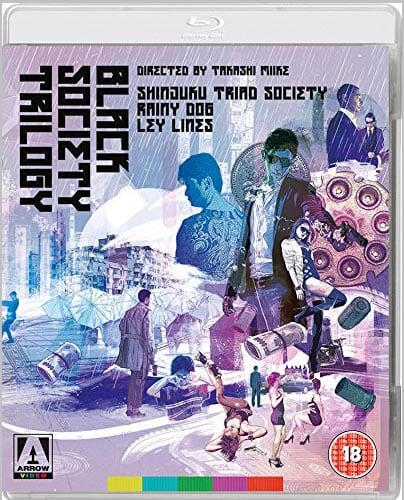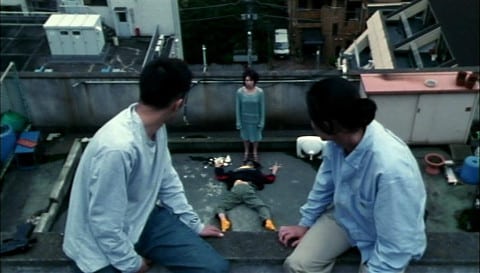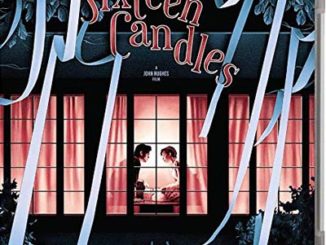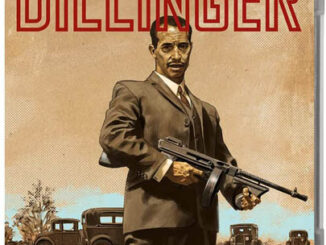Ley Lines (1999)
Directed by: Takashi Miike
Written by: Ichiro Ryu
Starring: Dan Li, Kazuki Kitamura, Naoto Takenaka, Tomorowo Taguchi
AKA NIHON KUROSHAKAI
Japan
ON DUAL FORMAT BLU-RAY AND DVD: 16TH JAN, from ARROW VIDEO in their BLACK SOCIETY TRILOGY SET
RUNNING TIME: 105 min
REVIEWED BY: Dr Lenera, Official HCF Critic
Desperate to leave Japan but unable to get a passport, half Japanese/half Chinese Ryuichi flees the countryside and heads for Tokyo, accompanied by his reticent brother Shunrei and his hyperactive friend Chang. Upon arriving in the Shinjuku red light district, they pick up Anita, a Shanghai native reduced to turning tricks, but end up locked in a room without their wallets. Desperate to earn some cash, they peddle toluene [an industrial solvent that causes a high when sniffed] and eventually encounter Anita again who joins their group. They decide to go to Brazil, but first of all they need money….
Though I personally preferred Rainy Dog and consider it to be slightly better overall, there’s no doubt that Ley Linès is a superior technical achievement and is probably a bit closer to typical Miike, and many first time viewers may very well deem it better. In a way it partly synthesises the two other films of the Black Society Trilogy, with the generally sober, character-based, leisurely approach of Rain Dog being given more than a few doses of the wilder, more extreme, and more action orientated nature of Shinjuku Triad Society. Once again we have a film which explores alienation and hopelessness in its protagonists, and with distinct racial aspects as its primary characters are either or mixed race or Chinese struggling to get by in Japan. Visually it’s often quite stunning and there are moments of genuine technical virtuosity, while there’s nice, if offbeat, bits of humour here and there. It does suffer from a real sense of marking of time in the first half where Miike just wants to put bits of sexual degeneracy on the screen, which certainly isn’t boring but can be called pointless, but around the half way point things start to become very good indeed and stay that way right to the end.
The film opens with four small children taunting two others who are obviously Ryuichi and Shurei who are being bullied because they aren’t wholly Japanese. The action is shown from a distance on a beach with an industrial backdrop and a bright red sun illuminating everything, in a lengthy single shot that is quite beautiful despite the artificial scratches put on it. Fast forward a few years and it seems little has changed as the Japanese state displays a similar racism towards a teenage Ryuichi, denying his requests to be allowed to travel. While Shunrei studies, Ryuichi cruises around on his moped in small town Japan, bored and disillusioned, until he decides to escape to the big city and is joined in his journey by Chang and eventually Shunrei. They’re soon making money by selling toluene, but Miike and his screenwriter Ichiro Ryu seem more interested in the trials and tribulations of Chinese hooker Anita who has to service clients with….um….unusual tastes [one such scene features a shot from inside her vagina as the guy’s face is looking inside it]. She’s another Miike female character who seems willing to screw anyone there and then even when she stops selling her body for money, though Miike sure gets pretty women [who can act reasonably well too] for these roles and Dan Li may be the prettiest one yet so I probably shouldn’t complain too much. Eventually she becomes a member of their group and they all decide to steal some money to finance their escape, and it’s here where the film really takes off as both the excitement and the tragedy build, and we become really invested in the characters and want so much for them to achieve their dreams.
The three main lads are well drawn and the whole film seems to be populated by eccentric characters. There’s the triad boss who gets young Chinese women to tell him Chinese fairytales [but woe betide if they aren’t good ones], the black street urchin Barbie who boasts of his resemblance to the doll of the same name but doesn’t look like her in any way shape or form, and a seriously deluded trafficker who is utterly convinced that his home brewed toluene will make everybody happy. There’s as cliched a bit of bawdy humour as you can imagine where Anita is upstairs with a client and the two are so energetic that dust and bits of dirt fall into the plates of Ryuichi and company who are having dinner in the room below. And we also have one character appeaing to be all but dead but his friends being relieved when he suddenly develops an erection, an erection that suggests a huge penis, after which they get Anita to wake the rest of him up. There are also some genuinely eccentric chuckles though that are not of a sexual naturer. The group is having breakfast on the roof of a skyscraper and Chang falls off the edge and we think he’s plummeted to his death. Actually, he’s then revealed to have only fallen 20 or so feet to a lower area, but still looks like he’s dead until he gets up with a bloody gash on his forehead but completely unconcerned about the fact.
There’s slightly more blood than in Rainy Dog but as with that film, this one doesn’t gloat on the violence and sometimes pulls back. When Anita is beaten up [of course] in the middle of the street, it’s shown from a great distance but this somehow enhances the casual horror of the brutality. Talking of streets, Tokyo’s Shinjuku district is often brilliantly photographed by Naosuke Imaizumi, be it the lengthy steadicam takes that follow characters all over the place, a long hand-held camera sequence as the teenagers are trying to sell drugs in the middle of Shinjuku showing the bustling environment of this area, or a character running in desperation to get to the others and his surroundings partly being bathed in red. Some moments adopt a colour scheme where the top of the picture is yellow, the middle brown, and the bottom green, yet it’s not done so excessively as to become irritating and detract the viewer from getting caught up in the situations of the characters. Whereas I think that overall Ley Lines is too uneven to totally succeed, there are times when it achieves quite a remarkable fusion of glorious, unabashed style and intelligent, character-based content.
The acting in this film is also very good throughout. Kazuki Kitamura and Michisuke Kashiwaya make a great pair as the two very contrasting brothers, and Tomorowo Taguchi [seen in the previous two pictures] is downright brilliant as the manic Ryuishi despite being almost twice the character’s age. The music score by Kôji Endô isn’t heard very often and when it is it’s entirely played by an accordion until at the very end. It works, kind of. The film also has an odd use of sound [and more scratchings over genitals] when some swearing is bleeped out. Considering that Miike is not a filmmaker whom I’d imagine would ever censor himself, it must have been done for a reason, though it’s not one I can work out myself. Ley Lines is overall a good, if nowhere near perfect, conclusion to a fairly strong trilogy of films which are linked thematically but which tell quite contrasting stories. Having only seen three of Miike’s films prior to these, I can say that the three films here serve as a good introduction to this interesting director and you can see the evolvement of his style, approach and world view in the course of watching them. There are a few things I could have done without, such as the principal female characters all being prostitutes, and sometimes Miike’s interest in showing “offbeat sexuality” partially gets in the way of everything else or seems out of place, but there’s a lot to enjoy in these movies and plenty of developing moviemaking skill too.
Rating: 









Ley Lines is easily the most visually ambitious of the trilogy and fortunately Arrow’s release serves it very well indeed. Sometimes the bright colours seem to almost bleed off the screen but I reckon that was what was intended by the director and the cinematographer. Again we have a very fine and detailed if a little too “relaxing” audio commentary by Tom Mes. There aren’t any other special features, but the disc more than ably rounds off Arrow’s release of these three films, a release which I do recommend.
SPECIAL EDITION CONTENTS:
*High Definition digital transfer
*Original uncompressed stereo audio
*Optional English subtitles
*New audio commentary by Miike biographer Tom Mes
*Original theatrical trailer
*Reversible sleeve featuring original and newly commissioned artwork by Chris Malbon
FIRST PRESSING ONLY: Illustrated collector’s booklet featuring new writing on the film








Be the first to comment